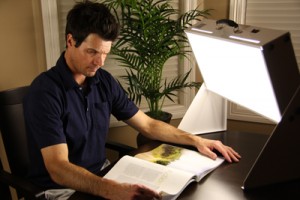The days are getting shorter and colder (like you needed to be reminded) and it’s a struggle to get any quality outdoors time. Lack of sunlight in the winter can lead to a well-known condition called winter depression.
The following was originally published here.
 Winter depression is a well-known condition that affects many people once temperatures fall and the shorter days of winter reduce the availability of natural daylight; in its most serious form, it is diagnosed as ‘seasonal affective disorder’ (more commonly known as ‘SAD’).
Winter depression is a well-known condition that affects many people once temperatures fall and the shorter days of winter reduce the availability of natural daylight; in its most serious form, it is diagnosed as ‘seasonal affective disorder’ (more commonly known as ‘SAD’).
Several methods of dealing with SAD are available today, but one of the most significant is the use of light therapy in the form of sun lamps and light boxes. These mimic the natural sunlight that is in such short supply in winter; they are simple to use and non-addictive, making them a more preferable form of treatment than, say, anti-depressant medication, or other methods that involve changes in everyday lifestyle.
Of course, natural sunlight is the best way to treat seasonal affective disorder but, during those times when it not so readily available, the next best way to deal with it is light therapy.
The Advantages of Light Therapy over Other forms of Treatment
These powerful light machines have been developed as a result of years of research into winter depression and how to deal with it effectively, and their significance cannot be underestimated, especially when compared with more conventional forms of treatment. They are non-addictive; once a light box or sun lamp has been purchased, there is no further financial outlay; light therapy is easy to use, and more practical and less time-consuming than altering the diet or taking up exercise, making it convenient for those for whom time is at a premium.
How and Why Light Treatment Works?
Light treatment works by exposing the sufferer to intense levels of light from a specially designed box that is simple to set up and use. Users do not need to look directly at the light; all they have to do is focus on the areas that it illuminates.
 It is well known that light affects various hormones and chemicals in the body; it also influences thehypothalamus, an area of the brain which regulates energy, appetite, and mood, all functions that are affected by seasonal affective disorder in winter.
It is well known that light affects various hormones and chemicals in the body; it also influences thehypothalamus, an area of the brain which regulates energy, appetite, and mood, all functions that are affected by seasonal affective disorder in winter.
When light levels are reduced in winter, sufferers, even those who are positive and upbeat at other times of the year, feel sad, anxious, and helpless. For them, and the people they live and work with, it can be confusing and bewildering, until they find out why; for such people, discovering that light therapy, can change the way they feel. They actually begin to feel.
How to use a Sun Lamp or Light Box?
- Put it on the table, or buy a stand (there are specials stands for sun lamps).
- Read the guide. Please read it. You will treat yourself much much better this way.
- Plug it in.
- Enjoy your Sunbathing.
Many people benefit from using the light box for between 15 to 30 minutes a day, but some enjoy longer periods of exposure. The beauty of this form of treatment is that it can be customized to suit the particular needs of the user and, because it does not need to be administered under clinical conditions, it can be used in a patient’s home or workplace.
Side Effects?
There is no need for light treatment to interfere or interrupt the normal day. Light treatment is not dangerous, though possible side effects may occur. Most are minimal, rare, and short-lived; a few patients may experience headaches, nausea, or eyestrain, but these are generally mild and disappear after a day or two.

0 Comments.